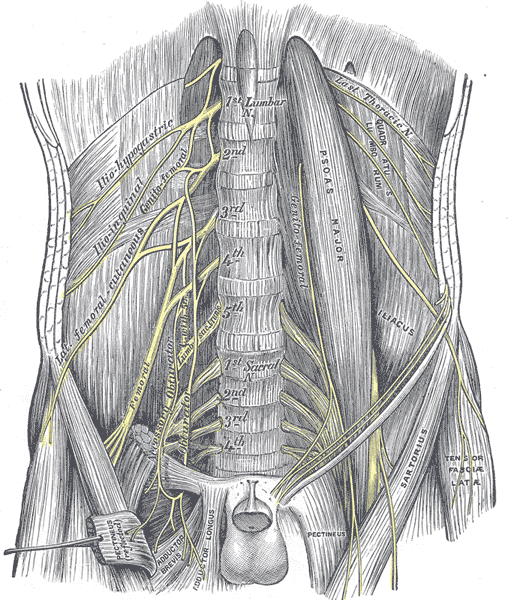Lumbar nerves
 From Wikidoc - Reading time: 2 min
From Wikidoc - Reading time: 2 min
Overview[edit | edit source]
The lumbar nerves are the five spinal nerves emerging from the lumbar vertebrae. They are divided into posterior and anterior divisions.
Posterior divisions[edit | edit source]
The medial branches of the posterior divisions of the lumbar nerves run close to the articular processes of the vertebræ and end in the Multifidus.
The lateral branches supply the Sacrospinalis.
The upper three give off cutaneous nerves which pierce the aponeurosis of the Latissimus dorsi at the lateral border of the Sacrospinalis and descend across the posterior part of the iliac crest to the skin of the buttock, some of their twigs running as far as the level of the greater trochanter.
Anterior divisions[edit | edit source]
The anterior divisions of the lumbar nerves (rami anteriores) increase in size from above downward.
They are joined, near their origins, by gray rami communicantes from the lumbar ganglia of the sympathetic trunk.
These rami consist of long, slender branches which accompany the lumbar arteries around the sides of the vertebral bodies, beneath the Psoas major.
Their arrangement is somewhat irregular: one ganglion may give rami to two lumbar nerves, or one lumbar nerve may receive rami from two ganglia.
The first and second, and sometimes the third and fourth lumbar nerves are each connected with the lumbar part of the sympathetic trunk by a white ramus communicans.
The nerves pass obliquely outward behind the Psoas major, or between its fasciculi, distributing filaments to it and the Quadratus lumborum.
The first three and the greater part of the fourth are connected together in this situation by anastomotic loops, and form the lumbar plexus.
The smaller part of the fourth joins with the fifth to form the lumbosacral trunk, which assists in the formation of the sacral plexus.
The fourth nerve is named the nervus furcalis, from the fact that it is subdivided between the two plexuses.
Additional images[edit | edit source]
-
The lumbar plexus and its branches.
 KSF
KSF